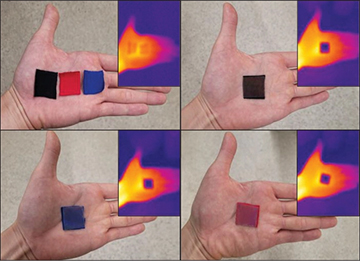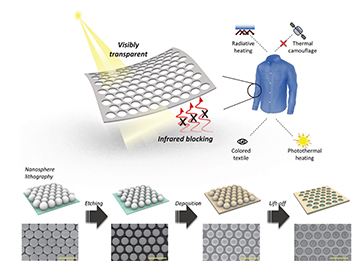Top: The new visibly transparent, infrared-reflective (VTIR) coatings from the research team could enable garments capable of both better body-heat trapping and thermal camouflage. Bottom: Schematic view of the fabrication process. [Image: Grainger College of Engineering, University of Illinois Urbana-Champaign] [Enlarge image]
As the world becomes ever more preoccupied with issues of energy and climate, environmentally friendly ways to keep warm in the winter look increasingly attractive. Researchers in the United States and the Republic of Korea have now developed a recipe for one such approach: nano-mesh coatings that allow high transmission of light at visible wavelengths but that block most emission of mid-infrared (mid-IR) wavelengths (Adv. Funct. Mater., doi: 10.1002/adfm.202201432).
The team found that its thin, visibly transparent and infrared-reflective (VTIR) coatings, applied to garments, could achieve radiative heating of as much 6.6 °C by trapping and holding in mid-IR radiation emitted from the human body. What’s more, when applied to sunlight-absorbing dark clothing, the coatings could potentially keep a human body warm at freezing outdoor temperatures without the need for additional bulky attire, according to the researchers.
The team believes that the VTIR coatings could open new opportunities for energy-smart “personal thermal management” at a time when climate change has brought weather extremes, potential power-grid failures and other imponderables into sharp focus. The researchers also see a potential counter-surveillance angle for the work—the infrared-blocking coatings could, they note, provide a highly effective camouflage strategy against nighttime thermal cameras.
Lost heat, lost opportunity
More than half of the heat dissipated by a human body indoors is frittered away in the form of mid-IR radiation, with the peak intensity at a wavelength of 9.5 µm. One typical strategy for trapping and retaining this mid-IR radiation, and thus effectively keeping a person warm in frigid conditions, is a metallic coating—think, for example, of the aluminum-coated Mylar “space blankets” used by emergency medical technicians.
Space blankets work because metals tend to be highly effective reflectors of mid-infrared radiation. The problem is that they also reflect pretty much all wavelengths in the solar spectrum, including visible ones. That makes them a challenge for other, non-emergency situations; life-saving as a space blanket might be in the wilderness, you probably won’t be wearing one at your next dinner party.
Nano-mesh strategy

Research leader Lili Cai. [Image: Grainger College of Engineering, University of Illinois Urbana-Champaign]
To get around that problem and create a mid-IR-reflective coating that would also let visible wavelengths pass through, the research team, led by Lili Cai of the University of Illinois, USA, focused on a strategy using a “nano-mesh”—a metallic film pierced with pores at just the right size to let visible light through, while effectively blocking mid-IR light. Cai had first suggested such a strategy for warming the human body in a study five years ago. In the new work, her team has zeroed in on a highly effective structure for such coatings and described a way to make them.
Fabrication of the metal nano-meshes (see image at top) begins by laying down a uniformly spaced monolayer of 1-µm-diameter polystyrene beads on a polyethylene terephthalate (PET) substrate. Reactive-ion etching then cuts down the size of the beads to a specific uniform smaller diameter. The beads are used as a mask for deposition of a sub-micron-thickness metal layer—gold, in this case—and are finally pulled off, using sticky tape and sonication in ethanol, to leave behind a metallic nano-mesh.
Blocking heat, transmitting light
Cai’s team conducted a series of experiments to see how the thickness and pore size of such a nano-mesh film would affect its ability to block mid-IR light while letting through visible and UV light. The researchers found that a hole size of 760 nm effectively reflected some 80% of mid-IR radiation, with the thickness of the layer making little difference. On the other hand, for visible-light transmission, the layer thickness had a big impact. A 100-nm-thick sample allowed transmission of an average of only 47.7% of light at a 550-nm wavelength, while an 18-nm thickness boosted the measured transmittance at 550 nm to an average of 65.8%.
The sub-70% visible-light transmission enabled by the nanoporous metallic films—while characterized as “decent” by the researchers—was a bit shy of what would be useful in actual applications. Taking a cue from earlier work by another group developing transparent electrodes for optoelectronic devices, the team next tried a three-layer oxide-metal-oxide (OMO) structure, with the 18-nm-thick metallic nano-mesh surrounded on either side by a 12-nm-thick TiO2 layer.
That tweak did the trick. The team found that OMO nano-mesh could transmit more than 80% of visible light (again, at the peak wavelength of 550 nm), while still effectively reflecting more than 80% of mid-IR radiation.
From radiative heating to thermal camo
With these results in hand, Cai’s team tested the coating’s effect in a variety of scenarios. In indoor tests, the team found that the OMO nano-mesh could “enable radiative-heating effect by 6.6 °C”—some 3.8 °C better than the radiative-heat-trapping power of commercial cotton blankets, and comparable to the values for Mylar emergency blankets.

Ordinary fabric swatches (top left panel) are ineffective at blocking thermal infrared radiation; swatches of the same colors, treated with the research team's nanopore coating, effectively screenout the mid-IR signal to the thermal camera. [Image: H.K. Woo et al., Adv. Funct. Mater., doi: 10.1002/adfm.202201432 (2022); CC-NC-ND 4.0]
The team also sized up the coating’s performance outdoors, applying it to a photothermal material (one that warms up when exposed to visible light). Because of the coating’s ability to let in visible and UV light from the sun while keeping bodily mid-IR thermal emissions from escaping, the coated photothermal fabric proved highly effective at providing warmth, with a performance superior to both cotton and Mylar blankets, according to the researchers. The team believes those advantages could enable outdoor activity in winter without the need for additional heavy clothing.
Finally, the researchers point out that their nanoporous VTIR coatings could offer a route toward camouflage clothing that works around the clock. Conventional camo garments, by blending into the background, can provide very effective daytime cover from observation in visible light, but they fail at night under infrared surveillance. By allowing transmission of visible light and colors while blocking thermal infrared, application of the VTIR coatings on top of conventional visible-light camouflage could enable both daytime and nighttime cloaking in the same material—from a counter-surveillance perspective, the best of both worlds.

